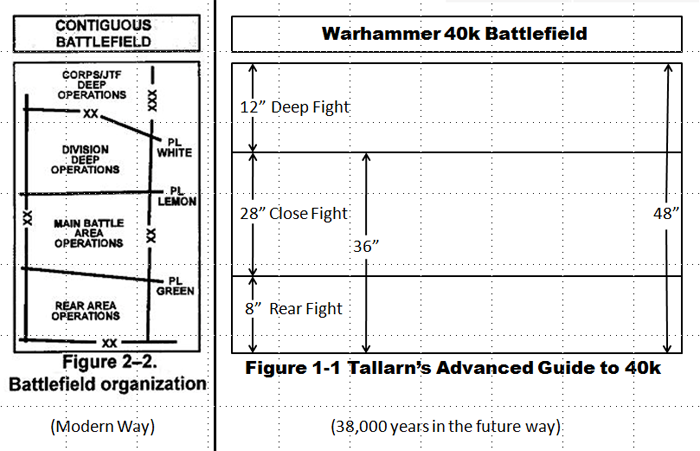In 1984 NATO adopted a doctrine of battle known of as ‘Air
Land Battle’. This doctrine divided the battle space up into a three parts -
the Rear Area, the Main Battle Area and the Deep Operations. Generally
speaking, different elements in the force were given responsibility for
separate areas with clear boundaries on those areas. The areas given to
specific units generally fit the capabilities and limitations of the forces assigned
to those areas. For example a B-52 would have responsibility for targets in the
Deep Operations area because of its ability to deliver large amounts of highly
explosive ordnance from the relative safety of high altitude but its inability
to actually hold any ground. An Infantry Company or Tank Platoon would be given
responsibility in the Main Battle Area due to their relatively short range,
compared to the aforementioned B-52, and their ability to take and hold ground,
which the B-52 lacks. Artillery with its longer range and high damage potential
but relatively low survivability, compared to the Infantry and Tanks, is more
suited to the Rear Area where it can support the Main Battle Area with relative
safety.
Now, I know that right now you are doing one of two things.
You are either:
A)
Wondering who in the hell cares about all this mumbo
jumbo.
B)
Already categorizing units in your army based on
the above criteria.
The rest of this ‘article’ is
written for those of you choosing option ‘B’. The rest of you should skip down
to the end for the instant gratification of our hawt chick with a gun for this
week. Now that that’s out of the way, let’s continue.
Starting from our table edge and
working forward, let’s look at the first area which extends 8” forward from our
table edge, the ‘rear fight’. What goes on in the rear area and what kinds of
units will we find there? Artillery loves the rear area - things like Long
Fangs, Thunderfire Cannons, Manticores, Whirwinds, Lobbas, Lootas and
Broadsides all enjoy hanging out back in the rear area. These units enjoy the
relative safety of the rear area where they can use their longer range and
higher strength to maximum effect against opposition targets at greater
distance. With their range they can affect anything in the Close Fight and some
things in the Deep Fight while maintaining a generally safe distance from all
the unpleasantness of the Close Fight.
Moving forward of the 8” imaginary
line we get into the area of the table I refer to as the Close Fight. Things
that excel in this area are units like Grey Hunters, Chaos Marines, Boyz Mobz,
Firewarriors, Gaunts and Guardians. Their relatively short range, high volume
of fire and ability to take and hold objectives makes them the perfect choice
for pushing forward from the rear fight and into the close fight. As these
units move forward they provide a screen for our units in the rear area and allow
them to continue with their primary mission of neutralizing your opponents
priority targets through the depth of the field. The Close Fight is where
battles are won and lost; the units assigned to fight there must be able to
survive incoming fire whether through superior numbers or superior armor while
simultaneously dishing it out.
Crossing through the Close Fight
we are now 36” across the table at another imaginary line that gets us to, what
I refer to as, the Deep Fight. What goes on in the deep fight is typically
things designed to disrupt your opponents support formations and draw units
away from the close fight. Being able to influence the deep fight does not also
mean you need to physically be there, things like Autocannons, Boivores and
Lobbas are perfectly capable of effecting units in the deep fight with their
long range. That being said, slinging bullets only goes so far and sometimes
you will need units to physically be in the deep fight to have the most effect.
Drop Pods, Spore Pods, Teleporting, Shunting, Jump Packs, Bikes, Outflanking
and transport Flyers are all great ways to deliver units into the deep fight
that allow you force your opponent to react to you and pull forces from the
close fight while hopefully eliminating some of the units hiding out in their
support echelons.
Thinking about the areas of the
battlefield in this way helps us to establish a framework of categorizing units
that will pay dividends in army construction and planning before you hit the
table. Understanding the ways in which units should be deployed and used in a
supporting system of overlapping capabilities goes a long way towards making
your army work in a cohesive manner where the whole is more than the sum of its
parts.
Still practicing_
T



Nice post Tallarn... Very instructive.
ReplyDeleteTallarn. If you approve it, I would like to translate it to Spanish and publish on my blog. All credits will be yours, of course.
ReplyDeleteThank you very much.
Sure, feel free to use whatever you like, just give me a link back ;)
Delete